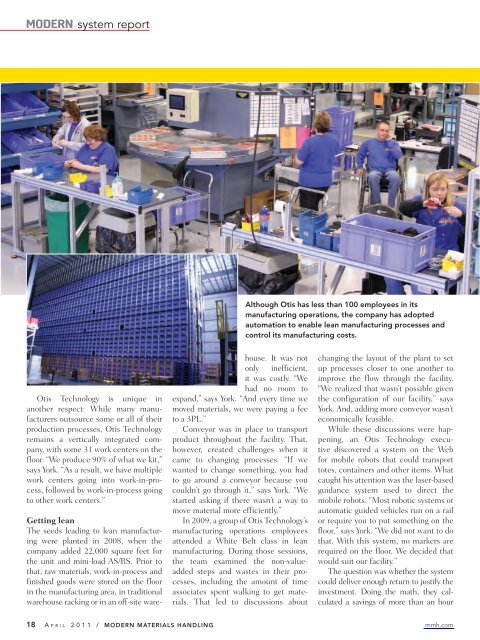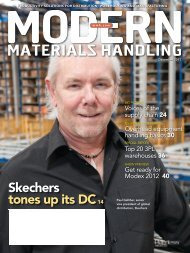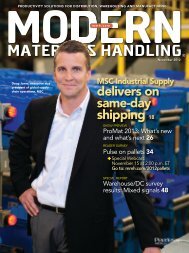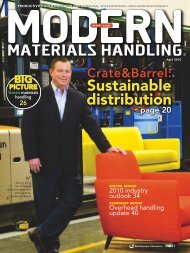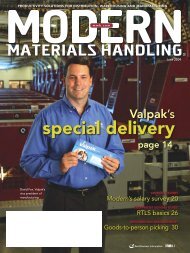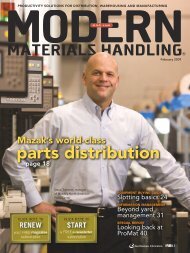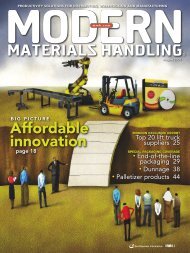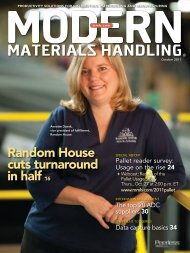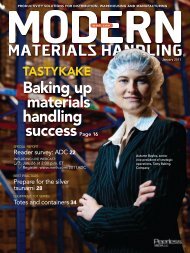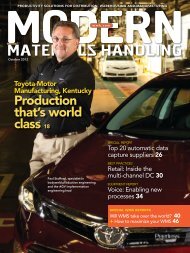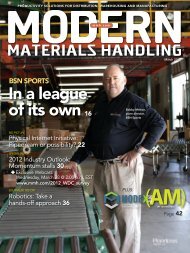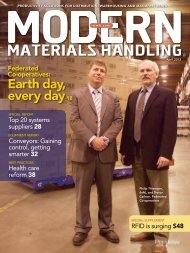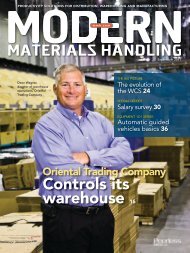modern system reportAlthough Otis has less than 100 employees in itsmanufacturing operations, the company has adoptedautomation to enable lean manufacturing processes andcontrol its manufacturing costs.Otis Technology is unique inanother respect: While many manufacturersoutsource some or all of theirproduction processes, Otis Technologyremains a vertically integrated company,with some 31 work centers on thefloor. “We produce 90% of what we kit,”says York. “As a result, we have multiplework centers going into work-in-process,followed by work-in-process goingto other work centers.”Getting leanThe seeds leading to lean manufacturingwere planted in 2008, when thecompany added 22,000 square feet forthe unit and mini-load AS/RS. Prior tothat, raw materials, work-in-process andfinished goods were stored on the floorin the manufacturing area, in traditionalwarehouse racking or in an off-site warehouse.It was notonly inefficient,it was costly. “Wehad no room toexpand,” says York. “And every time wemoved materials, we were paying a feeto a 3PL.”Conveyor was in place to transportproduct throughout the facility. That,however, created challenges when itcame to changing processes. “If wewanted to change something, you hadto go around a conveyor because youcouldn’t go through it,” says York. “Westarted asking if there wasn’t a way tomove material more efficiently.”In 2009, a group of Otis Technology’smanufacturing operations employeesattended a White Belt class in leanmanufacturing. During those sessions,the team examined the non-valueaddedsteps and wastes in their processes,including the amount of timeassociates spent walking to get materials.That led to discussions aboutchanging the layout of the plant to setup processes closer to one another toimprove the flow through the facility.“We realized that wasn’t possible giventhe configuration of our facility,” saysYork. And, adding more conveyor wasn’teconomically feasible.While these discussions were happening,an Otis Technology executivediscovered a system on the Webfor mobile robots that could transporttotes, containers and other items. Whatcaught his attention was the laser-basedguidance system used to direct themobile robots. “Most robotic systems orautomatic guided vehicles run on a railor require you to put something on thefloor,” says York. “We did not want to dothat. With this system, no markers arerequired on the floor. We decided thatwould suit our facility.”The question was whether the systemcould deliver enough return to justify theinvestment. Doing the math, they calculateda savings of more than an hour18 A p r i l 2 0 1 1 / <strong>Modern</strong> <strong>Materials</strong> <strong>Handling</strong> mmh.com
modern system reportper day per employee in travel time thatwould now be available for value-addedprocesses or future growth. That was sufficientto justify the investment.Going live with roboticsMobile robotics was also an ideal technologyfor Otis Technology’s new leanmanufacturing strategy. In the old strategy,all of the materials for a day’s productionwere stored in a work center.Associates would retrieve the materialthey needed as they needed it. Keepingtrack of inventory in that system wasdifficult and it led to a lot of work. Onesolution was to allocate no more thanone hour’s worth of production materialsto a work center at any given time.Changeovers were easier, but thatapproach still required a lot of walking.As the team did the value-streammapping associated with lean, all thatwalking emerged as a significant waste.That’s where the mobile robots cameinto play. The machines operate likesmall automatic guided vehicles, shuttlingcontainers and totes rather thanpallets through the facility. That wouldeliminate the walking. What’s more,they could be easily reprogrammed ifproducts, processes or a layout changed.After performing due diligence, OtisTechnology executives ordered threemobile robots. The implementation andtraining took about a week.The primary function of the robots isto deliver kanban totes and containersfrom the AS/RS to work centers in themanufacturing area. In that capacity,when an item runs out in a work center,an associate on the line presses a callbutton for a mobile robot. When therobot arrives, the empty container, anywaste cardboard and a kanban card areplaced on one of the robots. The robotautomatically delivers these back to theAS/RS system.There, an associate scans a bar codeon a kanban card. That signals the AS/RS to retrieve and deliver the replenishmentitems. Meanwhile, the robotgets an opportunity charge. Once theproduct is delivered to the operator, it’sloaded onto the mobile robot and deliveredto a workstation.In addition, the robots are also usedto deliver work-in-process from workcenters to the AS/RS for temporarystorage; to deliver finished goods fromthe packing area to the AS/RS for temporarystorage; or from the line or theAS/RS to the shipping area.Employees have adapted well toworking with robots. “When we come upwith a new idea, we go through a changemanagement process,” York says. “Weexplain the benefits, explain how we’regoing to use it and we repeat that severaltimes. There’s a level of employee trustso that we don’t have pushback.”The biggest accommodation hasbeen to add audio to the robots so thatPallets and totes arestored in an AS/RS (center).Product is then packed inkanban totes and deliveredjust-in-time to the assemblyline (top).employees hear them coming. “Theaudio system plays music, and we allowthe employees to request what we playso long as it’s appropriate,” York says.Along with improved inventoryaccuracy and productivity, York saysthe most visible change may simplybe that the facility is orderly. “If youlook around, you’ll notice that there’sno inventory sitting in the aisles andonly the supervisors are walking,” hesays. “Our employees are all involved invalue-added services.”Down the road, he adds, if productsor processes change, there is aninfrastructure in place to adapt. “AllI’ll have to do is add another robot,”he says. “I have flexibility that I didn’thave before.” Mmmh.com <strong>Modern</strong> <strong>Materials</strong> <strong>Handling</strong> / A p r i l 2 0 1 1 19


